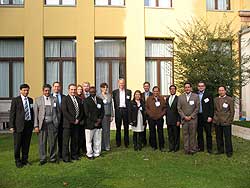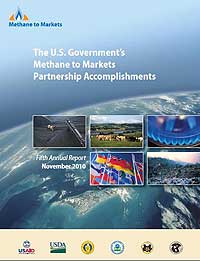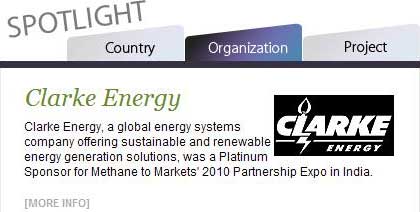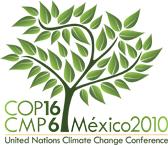Methane International
The Global Methane Initiative Update
Issue 22, January 2011
A New Look for the Global Methane Initiative

Building on momentum surrounding the recent Global Methane Initiative (GMI) launch, the Administrative Support Group (ASG) recently unveiled a new "look" to brand and unify GMI's website and materials. The new look is built around a refurbished logo, which features the methane flame and sun rays, a new beginning for the program and methane's far-reaching potential for global change.
 At the second
Ministerial Meeting in Mexico City on 1 October 2010, more than 65 participants
from 20 countries as well as the Asian Development Bank and Inter-American Development
Bank unanimously approved the creation of GMI
(PDF, 2 pp, 114 KB). Led by Mexico's Secretary of Environment and Natural Resources
Juan Rafael Elvira Quesada and U.S. Environmental Protect Agency's (EPA's) Office
of Air and Radiation Assistant Administrator and Steering Committee Chair Gina McCarthy,
the Partner delegations adopted a Ministerial
Declaration (PDF, 2 pp, 20 KB), urging stronger international action to
address near-term climate change.
At the second
Ministerial Meeting in Mexico City on 1 October 2010, more than 65 participants
from 20 countries as well as the Asian Development Bank and Inter-American Development
Bank unanimously approved the creation of GMI
(PDF, 2 pp, 114 KB). Led by Mexico's Secretary of Environment and Natural Resources
Juan Rafael Elvira Quesada and U.S. Environmental Protect Agency's (EPA's) Office
of Air and Radiation Assistant Administrator and Steering Committee Chair Gina McCarthy,
the Partner delegations adopted a Ministerial
Declaration (PDF, 2 pp, 20 KB), urging stronger international action to
address near-term climate change.
The ASG is redesigning many Partnership materials to reflect this new look. The former Methane to Markets website has now migrated to a new address: www.globalmethane.org. While this site has the same navigation and content as the previous site, it also features GMI's new logo and a dedicated GMI page, www.globalmethane.org/gmi, and refreshed fact sheets that highlight the Partnership's successes to date and GMI's newly expanded program areas (e.g., abatement, wastewater).
With these improvements in place, GMI is ready to move forward and fulfill its mission. Central to its progress are financial commitments from developed-country Partners and others to address climate change through GMI's methane mitigation efforts. The United States is pledging $50 million over the next five years to support methane emissions reduction projects and technologies, and other developed-country Partners are considering similar pledges.
For updates on GMI's progress and newly released materials, check the website often!
Subcommittees Met in November
Three of the subcommittees and the Wastewater Taskforce convened in November to continue their collaboration and discuss outcomes from the Ministerial meeting including the implementation of GMI. Some of the details from these meeting are listed below.
Wastewater Taskforce
The Wastewater Taskforce met concurrently with the Landfill and Agriculture Subcommittee meetings to focus on how best to fit wastewater into the Initiative. The taskforce discussed three options:
- Formation of a new Wastewater Subcommittee
- The inclusion of wastewater within the Landfill Subcommittee
- Holding wastewater meetings in conjunction with the Landfill and Agriculture Subcommittee meetings
The Taskforce agreed that these options should be included in a new wastewater whitepaper that will be prepared for the Steering Committee along with an estimate of the financial commitments that might be required for each option.
In addition, GMI is looking for countries that are interested in initiating activities in the wastewater sector. Please contact the ASG if your country would like to be included.

Oil and Gas Subcommittee
On 3 November 2010, the Oil and Gas
Subcommittee met in New Orleans, Louisiana. The meeting was held in conjunction
with the U.S. EPA's
Natural Gas STAR Annual Implementation Workshop
 on 1-3 November 2010. The workshop included a tour of a local natural gas plant
and the U.S. EPA's Natural Gas STAR Annual Implementation Workshop and Award Ceremony.
on 1-3 November 2010. The workshop included a tour of a local natural gas plant
and the U.S. EPA's Natural Gas STAR Annual Implementation Workshop and Award Ceremony.
The meeting attracted the largest turnout to date: 32 participants from five countries,
many attending their first Subcommittee meeting. Francisco Sucre of the
World Bank
 presented on the bank's carbon finance and technical networks. Participants also
had a chance to discuss the future of GMI. In addition, the Subcommittee decided
by consensus that the leadership would remain in place for now. The next
Oil and Gas Subcommittee meeting will be held in mid-2011, but its location
has not yet been determined.
presented on the bank's carbon finance and technical networks. Participants also
had a chance to discuss the future of GMI. In addition, the Subcommittee decided
by consensus that the leadership would remain in place for now. The next
Oil and Gas Subcommittee meeting will be held in mid-2011, but its location
has not yet been determined.
Landfill Subcommittee
On 11 November 2010, the Landfill
Subcommittee met in Venice, Italy along with the
Agriculture Subcommittee and the
Wastewater Taskforce. Nearly 20 participants from 14 countries attended
the Subcommittee meeting. Co-chair Gabriel Blanco of Argentina's
Secretariat of Environment and Sustainable Development
 welcomed participants and introduced new co-chairs Rachel Goldstein of the
U.S. EPA
welcomed participants and introduced new co-chairs Rachel Goldstein of the
U.S. EPA
 and Sandra Lopez from Colombia's Ministry of
Environment, Housing and Territorial Planning
and Sandra Lopez from Colombia's Ministry of
Environment, Housing and Territorial Planning
 .
.
Participants discussed charges given to the subcommittees from the recent Steering Committee, the transition from Methane to Markets to GMI, and how the landfill sector can contribute to the initiative's new wastewater focus.
Agriculture Subcommittee
On 12 November 2010, the Agriculture
Subcommittee met in Venice, Italy. The Subcommittee discussed the outcomes
of the Methane to Markets Ministerial meeting and the direction provided by the
Steering Committee. The Subcommittee also shared country updates and information
about the recently conducted Resource Assessments. The Subcommittee emphasized the
importance of countries creating and maintaining action plans and up-to-date reporting.
In addition, the Subcommittee announced that Jeremy Eppel of the
UK's Department of Environment, Food and Rural Affairs
 had resigned as co-chair; they offered their sincere thanks for all his work with
the Subcommittee. The group also reviewed future tasks, including creating international
calculator tools for anaerobic digestion projects and an international database
of anaerobic digestion systems. The next Agriculture
Subcommittee meeting will be held in conjunction with the
U.S. EPA's AgSTAR
had resigned as co-chair; they offered their sincere thanks for all his work with
the Subcommittee. The group also reviewed future tasks, including creating international
calculator tools for anaerobic digestion projects and an international database
of anaerobic digestion systems. The next Agriculture
Subcommittee meeting will be held in conjunction with the
U.S. EPA's AgSTAR
 Conference in Boise, Idaho, on 10-12 May 2011.
Conference in Boise, Idaho, on 10-12 May 2011.
U.S. Environmental Protection Agency Publishes Fifth U.S. Government Accomplishments Report
 The
U.S. EPA recently released the fifth annual
U.S. Government's Methane to Markets Partnership Accomplishments
The
U.S. EPA recently released the fifth annual
U.S. Government's Methane to Markets Partnership Accomplishments
 report, documenting the leadership efforts of the U.S. federal government to reduce
and recover methane around the world. In 2009, EPA continued its collaborative efforts
with the U.S. Department of State, the U.S. Agency for International Development,
the U.S. Department of Energy, the U.S. Department of Agriculture, and the U.S.
Trade and Development Agency to support the Methane to Markets Partnership. Together,
they conducted 26 workshops in more than 14 Partner Countries and trained approximately
2,000 people in all four sectors. The U.S. EPA also joined the government of India
in organizing the second Methane to Markets Partnership Expo, held in New Delhi
in March 2010.
report, documenting the leadership efforts of the U.S. federal government to reduce
and recover methane around the world. In 2009, EPA continued its collaborative efforts
with the U.S. Department of State, the U.S. Agency for International Development,
the U.S. Department of Energy, the U.S. Department of Agriculture, and the U.S.
Trade and Development Agency to support the Methane to Markets Partnership. Together,
they conducted 26 workshops in more than 14 Partner Countries and trained approximately
2,000 people in all four sectors. The U.S. EPA also joined the government of India
in organizing the second Methane to Markets Partnership Expo, held in New Delhi
in March 2010.
The report highlights the U.S. commitment to reduce and use methane emissions as well as details on progress in every sector. In fiscal year 2009, the United States provided $10.5 million to the Partnership, bringing the total U.S. financial commitment to the Partnership to more than $50 million since 2005. These funds have leveraged approximately $387 million in additional funding. These and other efforts are successfully bringing more than 300 methane emission reduction projects online in 18 Partner Countries. In 2010, these projects reduced methane emissions by 9 million metric tons of carbon dioxide equivalent (MMTCO2E) per year. When fully implemented, they will reduce emissions by approximately 61 MMTCO2E annually.
Organizations are in the Spotlight

Get to know your growing network and learn about other companies, Expo Sponsors, and recent project developments by visiting the updated GMI website! It now features a new spotlight on a Project Network member. The updated format highlights Project Network members in a condensed format that includes a brief introduction, information on current projects, and important links. More than 1,000 diverse organizations from six continents currently participate in the Project Network.
16th Conference of the Parties Convenes in Mexico
GMI Hosts Side Event
On 8 December 2010, nearly 65 participants attended
GMI's side event (PDF, 1 pp., 75 KB), which was held at the Green Solutions
Center in the Fiesta Americana Coral Beach Hotel. The event began with welcoming
remarks from Sandra Herrera of Mexico's
Ministry of Environment and Natural Resources
 (SEMARNAT).
(SEMARNAT).
The welcoming remarks were followed by two sessions; one highlighted the successes
of GMI Partner Countries including,
Brazil, China,
Mexico, and the United States. The
second session included Project Network members
from organizations such as MEGTEC
and PEMEX
 who discussed methane mitigation projects in the coal mine, landfill, and oil and
gas sectors.
who discussed methane mitigation projects in the coal mine, landfill, and oil and
gas sectors.
The ASG would like to thank SEMARNAT and the government of Mexico for hosting this event.
 On
29 November through 10 December 2010, the United
Nations Framework Convention on Climate Change (UNFCCC)
On
29 November through 10 December 2010, the United
Nations Framework Convention on Climate Change (UNFCCC)
 held the 16th Conference of the Parties
held the 16th Conference of the Parties
 in Cancun, Mexico. The meeting began with a welcome ceremony where Patricia Espinosa
Cantellano, Mexico's Foreign Relations Secretary and new President of the Conference,
addressed the 192 delegates in attendance. The 11-day conference included sessions
related to the Clean Development Mechanism, compliance under the Kyoto Protocol,
and information on greenhouse gas inventories.
in Cancun, Mexico. The meeting began with a welcome ceremony where Patricia Espinosa
Cantellano, Mexico's Foreign Relations Secretary and new President of the Conference,
addressed the 192 delegates in attendance. The 11-day conference included sessions
related to the Clean Development Mechanism, compliance under the Kyoto Protocol,
and information on greenhouse gas inventories.
The conference concluded with all nations agreeing to set a goal of limiting a rise in average world temperatures to below 2 degrees Celsius. Negotiators also agreed to create a Green Climate Fund to provide $100 billion a year to poor nations by 2020 in an effort to protect tropical forests and share clean energy technology (a funding source for this fund has not been identified). Additionally, negotiators tried to extend the Kyoto Protocol, which is set to expire in 2012, but there was no resolution. Next year's conference will take place in South Africa.
Recent Developments
- Livestock Project Protocol Approved for Mexico and the United States.
In September 2010, the Climate Action
Reserve
 approved Livestock Project Protocols for both Mexico and the United States, providing
guidance on calculating, reporting, and verifying greenhouse gas emission reductions
associated with installing a manure biogas control system for livestock operations.
For more information, visit
Mexico's Project Protocol
approved Livestock Project Protocols for both Mexico and the United States, providing
guidance on calculating, reporting, and verifying greenhouse gas emission reductions
associated with installing a manure biogas control system for livestock operations.
For more information, visit
Mexico's Project Protocol
 or the
U.S. Project Protocol
or the
U.S. Project Protocol
 .
. - Coal Mine Methane (CMM) Workshop in China. In October 2010, the
first United Nations Economic Commission
for Europe (UNECE) Workshop on Effective Methane Drainage and Use in Coal Mines
 was held during the
10th International Symposium on Coalbed Methane/CMM in China
was held during the
10th International Symposium on Coalbed Methane/CMM in China
 .
The U.S. EPA co-sponsored the workshop with the
China Coal Information Institute
.
The U.S. EPA co-sponsored the workshop with the
China Coal Information Institute
 and the State Administration
of Coal Mine Safety
and the State Administration
of Coal Mine Safety
 .
It focused on safety and technical issues related to gas extraction and control
in the underground environment. Additionally, UNECE distributed its
Best Practice Guidance for Effective Methane Drainage and Use in Coal Mines
(PDF, 86 pp., 1.9MB)
.
It focused on safety and technical issues related to gas extraction and control
in the underground environment. Additionally, UNECE distributed its
Best Practice Guidance for Effective Methane Drainage and Use in Coal Mines
(PDF, 86 pp., 1.9MB)
 .
. - Biothermica and Walter Energy Agree to Develop Ventilation Air Methane (VAM)
Projects. In October 2010, Project Network member
Biothermica and Walter Energy
 agreed to work together to develop VAM projects. The mission is to recover and mitigate
VAM emissions from all suitable current and future ventilation shafts at Walter
Energy's coal mines. The first project under the agreement will be operational in
2011, reducing greenhouse gas emissions by 330,000 tons of carbon dioxide equivalent
(TCO2E) per year. Ultimately, the implementation of the entire pipeline
of projects is expected to reduce emissions by more than 3 million TCO2E
per year. Read the
press release (PDF, 2 pp., 88 KB)
agreed to work together to develop VAM projects. The mission is to recover and mitigate
VAM emissions from all suitable current and future ventilation shafts at Walter
Energy's coal mines. The first project under the agreement will be operational in
2011, reducing greenhouse gas emissions by 330,000 tons of carbon dioxide equivalent
(TCO2E) per year. Ultimately, the implementation of the entire pipeline
of projects is expected to reduce emissions by more than 3 million TCO2E
per year. Read the
press release (PDF, 2 pp., 88 KB)
 for more information.
for more information. - Landfill Gas (LFG) Energy Project Completed in Ontario. In October
2010, a 2-megawatt LFG energy project was brought online at the Petrolia Landfill
in Ontario, Canada. The landfill, owned by Waste
Management
 ,
is providing electricity to homes in the area from the LFG. Waste Management was
able to complete the project a year after breaking ground. For more information,
see the news story in the
Waste Business Journal
,
is providing electricity to homes in the area from the LFG. Waste Management was
able to complete the project a year after breaking ground. For more information,
see the news story in the
Waste Business Journal
 .
. - United Kingdom Announces First Renewable Energy Project From a Brewery.
In November 2010,
BioEnergy News
 announced that United Kingdom's first renewable energy project to use gas from a
brewery plant is expected to come online shortly. Renewable energy specialist Bio Group
announced that United Kingdom's first renewable energy project to use gas from a
brewery plant is expected to come online shortly. Renewable energy specialist Bio Group
 has developed a proprietary anaerobic digestion technology for the project, which
should generate up to 4.4 million kilowatts of energy per year.
has developed a proprietary anaerobic digestion technology for the project, which
should generate up to 4.4 million kilowatts of energy per year. - Landfill in Ghana Installs Gas Collection System. In November 2010,
Blue Sphere Corporation
 announced that it had signed an agreement for the installation of a gas collection
system and flare with the right to negotiate for renewable electricity generation
in Accra, Ghana. The project consists of the installation of a gas collection system
and flare at the non-operational Oblogo and Mallam landfill sites, which are located
one mile from each other in Accra. The LFG extraction component consists of installing
a flare to capture and destroy methane gas contained in both landfills. Read the
press release
announced that it had signed an agreement for the installation of a gas collection
system and flare with the right to negotiate for renewable electricity generation
in Accra, Ghana. The project consists of the installation of a gas collection system
and flare at the non-operational Oblogo and Mallam landfill sites, which are located
one mile from each other in Accra. The LFG extraction component consists of installing
a flare to capture and destroy methane gas contained in both landfills. Read the
press release
 for more information.
for more information. - Municipality of Guayaquil, Ecuador Announces Request for Proposals.
In November 2010, the Municipality of Guayaquil, Ecuador, issued a
request for proposals
 for an LFG energy project at the Las Iguanas Landfill. The Municipality of Guayaquil
is looking for a company to help capture, treat, and use the LFG released from the
landfill. The deadline to apply is 14 January 2011.
for an LFG energy project at the Las Iguanas Landfill. The Municipality of Guayaquil
is looking for a company to help capture, treat, and use the LFG released from the
landfill. The deadline to apply is 14 January 2011. -
 U.S.
Overseas Private Investment Corporation (OPIC) Providing Nearly $300 Million in
Financing to Combat Climate Change. In December 2010, Elizabeth Littlefield,
President and CEO of OPIC
U.S.
Overseas Private Investment Corporation (OPIC) Providing Nearly $300 Million in
Financing to Combat Climate Change. In December 2010, Elizabeth Littlefield,
President and CEO of OPIC
 ,
announced that OPIC will provide at least $300 million in financing for new private
equity investment funds that could ultimately invest more than $1 billion in renewable
resource projects in emerging markets. Specifically, the funds will accelerate investment
in renewable energy, including solar, wind, hydro, tidal, and geothermal power as
well as waste and biomass. On 15 December 2010, OPIC issued a call for proposals
for private fund managers investing in renewable energy, resource efficiency, and
the preservation of scarce natural resources. The deadline to submit a proposal
is 11 February 2011. For more information,
read the announcement
,
announced that OPIC will provide at least $300 million in financing for new private
equity investment funds that could ultimately invest more than $1 billion in renewable
resource projects in emerging markets. Specifically, the funds will accelerate investment
in renewable energy, including solar, wind, hydro, tidal, and geothermal power as
well as waste and biomass. On 15 December 2010, OPIC issued a call for proposals
for private fund managers investing in renewable energy, resource efficiency, and
the preservation of scarce natural resources. The deadline to submit a proposal
is 11 February 2011. For more information,
read the announcement
 and visit the
website for more information on the call for proposals
and visit the
website for more information on the call for proposals
 .
.
Send in your announcement for our next issue. Also, visit the news and events page for information on past GMI gatherings.